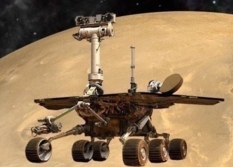A.J.S. Rayl • Feb 03, 2015
Mars Exploration Rovers Update: Opportunity Completes 11th Year of Surface Operations!
Sols 3889 - 3918
On January 24, 2015 something wonderful happened on Mars. Opportunity completed her 11th year of exploring the surface of the Red Planet!
The veteran Mars Exploration Rover couldn't exactly go to Disneyland to celebrate this amazing achievement, so she did what she loves to do – roved on. The robot field geologist is on the way now to check out a small, bizarre crater, finish the first marathon on Mars, and she has an "E ticket" to a scientific wonderland the likes of which no Red Planet robot has ever seen.
"We have begun our 12th year on Mars," said Steve Squyres, MER principal investigator, of Cornell University, during an interview in late January. "It's fantastic."
For a mission that started out as a three-month tour, it is incredible by any account. In acknowledgment of the achievement, NASA-JPL released the rover's latest panorama. Taken from the summit of Cape Tribulation, the highest peak the rover has ever climbed, the partial self-portrait shows Opportunity holding up her robotic arm and "waving" the U.S. flag.
In the annals of exploration, MER is already a legendary expedition, in part because Spirit and Opportunity had personalities from the get-go and seemed imbued with the best the human spirit has to offer. Still, Opportunity has completed another Earth year on Mars. It's a huge achievement for American engineering and one that has enabled the rover and her team to uncover compelling evidence about wet environments in ancient Mars and advance our knowledge about the planet that could someday be an outpost or, perhaps, home. And there's more, much more for the robot to learn just a few hundred meters to the south.
Back in 2003-2004, few people actually believed that Spirit or Opportunity would land, much less complete their three-month primary missions. The odds were solidly stacked against them with 2 in 3 missions to Mars, mostly orbiters, failing. But Spirit delivered the magic and captured the attention of the world when she bounced to a landing on January 3, 2004 (PST). Within 72 hours, more than 1.2 billion Earthlings jammed the NASA-JPL and mirror websites to see the first postcards Spirit sent home.
Three weeks later, Opportunity followed, bouncing to a stop in Eagle Crater and scoring the first interplanetary hole-in-one at 9:05 pm PST January 24th / 5:05 am UTC January 25th. When the rover opened her eyes, she was staring at the first bedrock found on the surface of Mars.
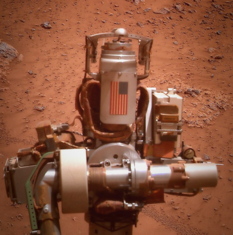
Opportunity's Flag
At the summit, Opportunity held its robotic arm so that the U.S. flag would be visible in the scene. The flag is printed on the aluminum cable guard of the rover's rock abrasion tool and is a memorial to victims of the Sep. 11, 2001, attacks on the World Trade Center in New York. Workers at Honeybee Robotics in lower Manhattan, less than a mile from the World Trade Center, were making the rock abrasion tools for Opportunity and Spirit. In the weeks following the attacks, they recovered the aluminum used for the cable guard was from the site of the twin towers, and adorned it with the flag.NASA / JPL-Caltech / Cornell / ASU / S. Atkinson
From the beginning, Spirit had the tougher mission. Gusev Crater is more rugged and its climate harsher than Opportunity's Meridiani Planum site. And where Spirit had to work hard for every achievement, Opportunity seemed to have them handed to her. But Spirit gave it her all, exploring for more than 6 years, literally defining MER mettle, and raising the bar for all future Mars rovers. During the mission's fifth Martian winter in 2010-2011 however, stuck near Home Plate and unable to angle her solar arrays to the Sun, Spirit went silent. Her identical twin roved on.
During the last 11 years, Opportunity has racked up about 41.95 kilometers (41,947.28 meters / 26.06 miles), crater-hopping across the Meridiani Plains. From Eagle, the robot field geologist has visited more than a dozen craters with significant stops made at Endurance Crater, where for the first time ever a rover drove safely into a crater on Mars and back out, and then Victoria Crater, where the rover spent two Earth years exploring inside and outside.
In September 2008, Squyres made the announcement and Opportunity left Victoria Crater, boldly embarking on the impossible journey to Endeavour Crater. For nearly three Earth years, the rover drove and drove and persevered. Finally in August 2011, the rover pulled up to the huge 22-kilometer (13.7-mile) diameter, ancient Noachian Period crater.
Since then, the robot field geologist has traveled back in Martian time some 3 to 4 billion years, further than any surface mission. And, Opportunity has sent home solid evidence for near-neutral water – water much like humans could drink – and the oldest rocks ever found on Mars, evidence that supports the belief that Mars was once warmer and wetter and more like Earth.
"It's satisfying to look back, but the most satisfying part of all to me right now is we're still looking forward," said Squyres. The expedition along Endeavour Crater's western rim continued in January, mostly uphill as Opportunity climbed to the summit of Cape Tribulation, and then down slope as the rover got back on the route south toward Spirit of St. Louis Crater and Marathon Valley.
"We've been putting as much as we can into the drives and doing a lot of imaging, documenting the outcrops and their color patterns as we go," said Ray Arvidson, MER deputy principal investigator, of Washington University St. Louis. "When we stop, we take end-of-drive images down and the science team recommends targets that represent typical outcrops in the immediate vicinity for the rover to image in Pancam color."
Although it has been widely reported that Opportunity lost her memory, the rover does have back-up memory that it can and has been using as she continued her trek in January. In fact, like so many months for this rover, January was all about driving and despite being somewhat handicapped, she managed to put 380.03 meters (about 0.24 mile) in the rear view mirror.
A plan devised by the MER software engineers to upgrade the Opportunity's flight software, and then reformat Flash again, this time masking off the troublesome sector in that memory drive was conditionally approved during an independent review on January 15th. The review board required the MER engineers conduct some additional testing and basically dot a few procedural i's and cross a few t's.
"This is a major thing and we've never done it before," said Squyres. "There's a lot of confidence that it will go well, but it's the kind of thing we want to approach very judiciously."
The rover's Flash memory degraded noticeably in 2014 and was causing Opportunity to suffer increasing "amnesia" events, where she couldn't write to her Flash before going to sleep, thus "forgot" the data when she woke up, and unwanted reboots. The issues all seemed to be emanating from one sector of 7 for storage in the Flash drive, as reported in previous MER Updates in 2014.
Flash memory is non-volatile memory the retains data even after the rover shuts off the for the night and goes to sleep. But the MERs were also equipped with random access memory (RAM) for volatile data storage, just in case, so it was dubbed crippled mode during development. When two Flash reformats in the latter part of 2014 didn't solve the issues and the reboots increased, the MER team took Flash memory off-line, so to speak, in December and had the rover switch to storing data in RAM.
As volatile memory, RAM only retains data while the rover is up and on. That means the data disappears when Opportunity goes to sleep so the limitation is that the rover must downlink all telemetry, images, and science data the same day she acquires them.
"We're constrained by total data volume on any given day," said Ashley Stroupe, one of the rover planners (RPs) at JPL. "We can't take more than the RAM can hold and we can't take more than the downlink will allow us. But this workaround is helping us meet our near time goal of getting to Marathon Valley with enough time to conduct a science campaign before we have to get to where we need to be for the next winter. That's a big deal."
Pending one more final review, the new flight software will probably be installed sometime in February, and the Flash reformat will follow sometime after that. For now, no one's in a rush.
In part, that's because the MER team, known for its work-arounds and adaptability, has adapted. "We've had no problems operating the rover with only RAM memory," said Stroupe. And, since Opportunity is on a beeline to Marathon Valley and not in an intensive science mode collecting a lot of data, the timing for having to switch to a volatile memory mode was fortuitous.
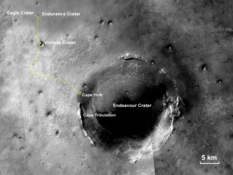
11 years of roving Mars
The gold line on this image shows Opportunity's route from the site of its Jan. 24, 2004 (PST) landing inside Eagle Crater, upper left, to its location at the Cape York section of Endeavour Crater's western rim, in late May 2013. The rover has since driven to Cape Tribulation, and at the end of January 2015 was closing in on Spirit of St. Louis Crater, a shallow crater barely visible below Cape Tribulation, near the bottom quarter of the image. The base image is a mosaic of images taken by the Context Camera from Malin Space Science Systems onboard the Mars Reconnaissance Orbiter (MRO). MER science team member and Planetary Society contributor Larry Crumpler made this traverse map at the New Mexico Museum of Natural History & Science, Albuquerque.NASA / JPL-Caltech / MSSS / NMMNHS
"Operating in its persistent no Flash mode, the vehicle is behaving normally. The rover is responsive and doing exactly what we want it to do," elaborated John Callas, MER project manager, at the Jet Propulsion Laboratory (JPL), home to all NASA's Mars rovers. "We have been able to drive and drive effectively. With the exception of the Flash, it's been normal business operations."
Despite her age, broken shoulder, and arthritic wheel, Opportunity keeps on going and going. "Everything is holding together mechanically and we're truckin' along," said Squyres. "Power is fine. Things are going good. We'll see how things are tomorrow, but today things are good," he added, pausing. "Every day is a gift at this point."
Year after year, Opportunity has proven to be a gift that keeps on giving. Caution considered, plans are being made for this little golf-cart-sized 'bot well into the future. Some team members are even dreaming of a visit to Iazu Crater once the rover's work at Endeavour is done.
In the near future however, the rover's greatest threat, once again, looks to be not on Mars but on Earth. NASA's fiscal year 2016 budget states: "NASA plans to end Opportunity operations by FY 2016."
Given that MER – Spirit and Opportunity – are one of the most beloved and recognized planetary missions, second only to Apollo by many appraisals, it remains to be seen how the public will respond should the space agency actually try to pull the plug on a healthy, roving rover that's still uncovering textbook changing science and pushing the limits of American engineering.
That is when and this is now and the MER team and their rover are forging ahead. "We're basically pedal to the metal to try and get down to Marathon Valley," said Bill Nelson, chief of MER engineering, of JPL.
The MER mission was drawn to Marathon Valley by orbital data that indicate there are phyllosilicates there, multiple kinds of clay minerals there, signs of past water. Among whatever surprises and new mysteries Mars may offer up, the scientists are hoping to find more of the deepest stratigraphic unit that Opportunity uncovered at Matijevic Hill on Cape York back in 2012-2013 and is now known as Matijevic Formation. "We spent months exploring Matijevic Hill and Marathon Valley looks bigger and better," said Squyres. "There's a chance that we will see similarly old rocks there."
Spirit and Opportunity were deemed amazing when they turned 1. Now that Opportunity's has turned 11, well … the robot is an engineering marvel. Considering the thermal cycling, the constant temperature changes and natural expansion and contraction of her metal parts, or the ubiquitous, powdery Martian dust, or the fact that she's had to rely on the same lithium-ion battery, or any number of other things, this robot field geologist is actually an engineering miracle.
But it also takes a dedicated support crew to care and tend to the robot so far away on an alien planet and Squyres has pulled in and enthused a loyal, willing team to join him in pioneering the first surface expedition across Mars. In the process, the core team of engineers and scientists has created a model of collaboration suitable for application to just about any human endeavor – especially those of the broken down Congress.
Regardless of how many people grok what MER has accomplished or what Opportunity's latest achievement is or what life-threat is coming down the political pipeline, the rover and her team are rolling on, undaunted, as explorers must. "We are so far beyond what people expected from this rover and it continues to be remarkable," said Callas. "Now we're looking forward to crossing a marathon, the first off-Earth marathon, the first Martian marathon."
"I think we are all aware how lucky we are, how amazing this is," Stroupe reflected. "For as long as Opportunity goes, we're all going to treasure the experience."

NASA / JPL-Caltech / Cornell / ASU
Cape Tribulation Panorama
Opportunity reached the summit of Cape Tribulation, located along the western rim of Endevour Crater, in early January 2015, about three weeks before the 11th anniversary of her spectacular landing on Mars in January 2004. From the highest elevation she has ever been, the robot then spent a week taking the hundreds of component pictures for this image with her panoramic camera (Pancam). Spanning about 22 kilometers (about 13.7 miles) in diameter, Endeavour's interior and rim stretch out before the rover in this 245-degree panorama centered toward east-northeast. The Pancam team processed this version in what they call "false color," so the scientists can better distinguish the various geologic features and structures.When January 2015 dawned at Endeavour Crater, Opportunity was about 100 meters from the summit of Cape Tribulation, a way station along the western rim of Endeavour Crater on the route south to Spirit of St. Louis Crater and Marathon Valley. The plan was for the robot field geologist to climb to the summit, take a panorama, and then get back on the road.
With 41.62 kilometers (25.86 miles) on her odometer, the solar-powered rover was producing power levels hovering around 435 watt-hours under hazy skies registering a Tau (atmospheric opacity) of 1.041, and with a respectable solar array dust factor of 0.631.
Since Opportunity's Flash memory degradation had caused multiple, unwanted reboots of on each wake-up and was temporarily taken out of use in December, the team continued to operate the rover without using the non-volatile storage system throughout January. Instead, the rover planners (RPs) were real-time commanding the robot on the first sol of each plan and directing her to use the volatile random access memory (RAM) for temporary storage of telemetry.
Real time commanding is team consuming however, and requires some of the crew to be on Mars time, noted Callas. "According to JPL policy, all real time commands has to have a separate pair of eyes," Nelson explained.
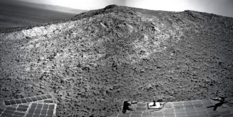
Summit ahead
As January 2015 took hold, Opportunity was just 100 meters (328.08 feet) 100 meters from the summit at Cape Tribulation shown here. During the last week of December 2014 and into the New Year's holiday, the veteran Mars rover took a series of images with her Pancam that Stuart Atkinson processed into the image we present here. For more of Atkinson's work, check out his website: The Road to Endeavour.NASA / JPL-Caltech / Cornell / ASU / S. Atkinson
Past that, the only downside to Opportunity having to rely on RAM is that it requires the rover to downlink all data acquired before it shuts down for the night. "We have to spread our imaging out, because right now we can't just save it in Flash to download whenever we choose, so it does slow us down a bit," said Nelson. "But fortunately, this really hasn't stopped our progress."
With drives on Sol 3893 (January 5, 2015) and Sol 3894 (January 6, 2015), Opportunity scaled the summit of Cape Tribulation, the highest point so far on the western rim of Endeavour Crater and the highest point this rover may ever hike. From that vista point – 135 meters (443 feet) above the plain of Botany Bay, which the rover crossed in mid-2013 – an elevation almost as high as the Washington Monument, the robot field geologist took in her surroundings. After a small turn in place on Sol 3895 (January 7, 2015), she adjusted her Panoramic Camera (Pancam) and began collecting the component images for the Cape Tribulation Panorama.
A 245-degree view centered toward east-northeast, the panorama spans the interior of Endeavour and extends to the rim of another crater on the horizon. The rover's U.S. flag, which is printed on the aluminum cable guard of her rock abrasion tool (RAT) and is visible in the lower right portion of the image, is actually a memorial to the victims of the 9/11 attacks on the World Trade Center in New York City.
On September 11, 2001, workers at Honeybee Robotics in lower Manhattan, less than a mile from World Trade Center, were making the RATs for Opportunity and Spirit when al-Qaeda carried out the first major acts of terrorism on U.S. soil and killed a total of 2,977 innocent people in NYC, Washington DC, and Shanksville, Pennsylvania. It was the single deadliest day in history for New York City firefighters: 343 were killed.
In addition to the loss of lives, the Twin Towers and four airliner jets were destroyed and an estimated $10 billion worth of property and infrastructure damage was incurred in NYC alone. And the fallout continues as respiratory and other health issues related to the attacks are on the rise.
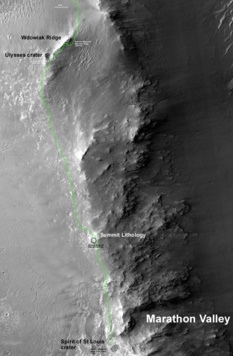
Opportunity's route south
As of the end of January 2015, the rover was confronting a ripple field, the only thing between her and Spirit of St. Louis Crater, labeled at the bottom of this image. "It doesn't look like a typical impact crater," said MER Deputy Principal Investigator Ray Arvidson. "It seems really odd...it has a mound of rocky stuff kind of off-set from the middle a little bit...and demands we get up close to figure it out." The base map is an image taken by the HiRISE camera onboard MRO.NASA / JPL-Caltech / UA / NMMNHS
During the immediate aftermath of 9/11 and in the weeks that followed, the Honeybee engineers working on MER legally recovered some aluminum from the site of the Twin Towers and used it to fashion the cover for the RATs, then adorned it with the flag to create the memorial that Opportunity holds up on the Cape Tribulation Panorama.
There is a stillness in this panorama. And even as Islamic extremists continue to wage evil on Earth, there is a counterpoint to be found in this postcard from Mars, a meaningful moment captured for all humankind to ponder, of spirit and vision and courage to believe in bolder, better, bigger things and the greater-good possibilities of our species.
Opportunity carried on at Cape Tribulation, finishing up her imaging work from the summit. In addition to the panorama, she took Pancam images of bedrock targets named for frontiersman Hugh Glass, archeologist-explorer Gertrude Bell, and Delaware trapper-scout Black Beaver.
"We got a lot of nice pictures of impact crater breccia, which is what you'd expect here," said Squyres. "But nothing that has caused us to slam on the brakes and say: 'Hey we've got to stop and investigate this.'"
So on Sol 3902 (January 14, 2015), Opportunity departed the summit of Cape Tribulation. From her vista point, she roved southeast along the charted route toward the next destination, Spirit of St. Louis Crater, taking pictures of Endeavour's rim rocks along the way.
"The [rim rocks] seem to be tilted toward the west on the outboard side of Endeavour where we are now," noted Arvidson. "As we head into Marathon Valley, will the tilt turn toward the east? Will we drive over a hinge zone as we head eastward into Marathon Valley?"
Time and another few hundred meters will tell.
Meanwhile at JPL, the MER software engineers presented their strategy to fix Opportunity's Flash memory issues to an independent review board on January 15th. The plan was to upgrade Opportunity's flight software to R9.4. That would enable the reformat of Flash to mask off the troubled sector or bank on the memory drive. After giving the flight software a while to run, they would then reformat Flash and then the rover could resume using the remaining six banks of the non-volatile file system in normal operations.
"The review board approved our action or the concept to change the flight software to make possible the masking of Flash bank 7 and they approved masking bank 7," said Nelson. "They conditionally approved the procedures for making these changes, subject to about a dozen action items to be completed first."
"We need to address some things we were going to do anyway and we've completed most of those items," Callas added. "Probably our biggest step is to make sure that we capture all the documentation related to this change."
Once the action items are completed and the Mars Program Office is satisfied the MER team has done everything the board required, the go-ahead should follow. "Only then may we do the commanding," said Nelson.

NASA / JPL-Caltech / Cornell / ASU
Cape Tribulation Panorama in Martiancolor
This version of Opportunity's Cape Tribulation Panorama was processed by the Pancam team in approximate true color by combing exposures taken through three of the Pancam's color filters, centered on wavelengths of 753 nanometers (near-infrared), 535 nanometers (green) and 432 nanometers (violet). The left edge is toward west-northwest and the right edge is southward. Rover tracks imprinted during the rover's approach to the site appear on the left. The far horizon in the right half of the scene includes portions of the rim of Iazu Crater farther south.During the review, the MER software engineers mentioned taking a spare bit in one of the rover's registers and making a flight software change to control permanent crippled mode. "That's when one of the former MER [team] said it had already been done!" Nelson said.
So the MER engineers headed to the testbed, ran successful tests that afternoon, and with Callas' approval, commanded permanent crippled mode the following uplink to be effective the morning of the rover's Sol 3905 (January 16, 2015).
That meant the RPs would no longer have to real time command Opportunity every working sol. Rather, the rover would boot up using RAM autonomously on every wake-up. "We're still not completely back to normal, but we've been able to mitigate and work around quite a lot of the restrictions we had when we started using RAM," said Stroupe.
"Because we're bypassing Flash, we're bypassing all the problems we had with Flash," Nelson added. "We have not had any reboots or loss of sequence control since we began operating in crippled mode, in December."
With Opportunity booting up in RAM autonomously, the team was able to relax. "It was important to give the team some time off to relax from the hard push they had been under to get us to this point," said Callas. "We then were able to relax the pace of testing, because we could pretty much operate the rover normally without the Flash and there wasn't the urgency."
Once the team passes the final review, the plan is to first uplink and carry out a flight software update on Opportunity, from R9.3 to R9.4. "That update will install the capability of masking off Flash, but we won't actually do it," said Nelson. "The thinking is we'll give it a little time on new flight software before we do the reformat and mask off the bad sector in Flash."
"We're doing so well these days that nobody wants to rush it," said Squyres. "Believe me, I don't want to operate without Flash for the rest of the mission, but we are not going to rush this process."
That noted, the flight software update is expected to be uplinked in February and the Flash reformat will follow after that. Provided it all goes as planned, Opportunity will return then to normal operations.
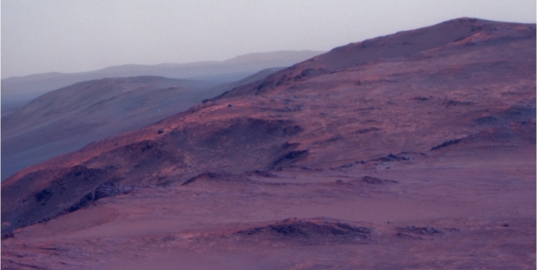
NASA / JPL-Caltech / Cornell / ASU
Marathon Valley west extent
Using her stereo panoramic camera (Pancam), Opportunity took this image on Jan. 24, 2015, 11 years after she bounced to a landing. It reveals a glimpse of the walls of Marathon Valley. The big gash on the left is the westward extent of the valley where clay minerals await discovery. When MER Deputy Principal Investigator Ray Arvidson first saw the raw images of that gash, he called them "blow-away spectacular." To which MER Principal Investigator Steve Squyres responded: "Yowza wowza!" The Pancam team processed the image into this "false color" version.On Mars, the veteran robot pressed on toward Marathon Valley, driving on Sol 3905 (January 16, 2015) and Sol 3908 (January 21, 2015), bringing her total odometry to 41.80 kilometers (25.97 miles) and within 300 meters (984 feet) of Spirit of St. Louis Crater and Marathon Valley, as the Martian cow would fly.
As she drove, Opportunity continued making good use of her time and Pancam. "We designed the Pancam to be a tool to investigate outcrops from a considerable distance," Squyres reminded. "We're doing just what we would be doing if we were there. We're working our way down to Marathon Valley, but keeping our eyes open as we go."
During the last week of January, Opportunity drove five more times, on Sols 3909, 3911, 3914, 3916, and 3918 (January 22, January 24, January 27, January 29, and January 31, 2015), putting more than 130 meters (about 426 feet) in her rear view mirror. The robot field geologist sent home Pancam images of breccia bedrock targets dubbed for mountain men, John Colter, Major Andrew Henry, and John "Grizzly" Adams along the way.
"We're getting some good imaging," said Squyres. "In terms of science there's nothing dramatic until the Sol 3909 raw images showing us our first look at Marathon Valley's walls," said Arvidson.
The raw Pancam images that Opportunity returned from Sol 3909 (January 22, 2015) offer the first real glimpse inside the western extent of Marathon Valley from the ground. As soon as he saw them, Arvidson dashed off an email to Squyres: "The Sol 3909 Pancam drive direction mosaic is blow-away spectacular. Marathon Valley walls are just showing up and they're rugged and interesting," he wrote.
"Yowza wowza! " responded Squyres. "That's very cool. This is going to be great!"
On Sol 3911 (January 24, 2015), Opportunity drove 38.88 meters, a jaunt that took her total mileage past 41.84 kilometers (41,842.94 meters) or 26 miles. "We're bearing down on 42 kilometers," said Nelson. After that, it's only about another 200 meters to complete the first marathon on Mars."
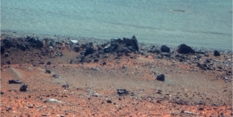
Rim rocks
In the sols or Martian days after she departed the summit of Cape Tribulation, Opportunity took this image of rocks along Endeavour's western rim with her Pancam. "The rocks seem to be tilted toward the west on the outboard side of Endeavour where we are now," noted MER Deputy Principal Investigator Ray Arvidson. But, he wondered: "As we head into Marathon Valley, will the tilt turn toward the east?" The Pancam team processed this version in "false color," which enables the scientists to better distinguish the different geologic features.NASA / JPL-Caltech / Cornell / ASU
But first the MER mission had another record to chalk up. Within hours of that drive, at 1:17 am local Mars time on Sol 3912 (January 25, 2015), Opportunity officially completed her 11th year of exploration. "The exact time the rover first bounced onto Mars was 8:54 PST January 24, 2004 / 4:54 am UTC January 24, 2004, but on Mars, it was 1:17 am local Martian time on the rover's Sol 3912," said Nelson. Opportunity then bounced for about 13 minutes before rolling to a stop inside Eagle Crater.
"We knew exactly when that time would hit and were thinking about Opportunity and 11 years at that time," said Stroupe. "A lot of us posted things on Facebook or exchanged emails, and we got a lot of nice responses and support from friends who have nothing to do with the project. We were keenly aware of where we were and where we are."
Later on Sol 3912, Opportunity began the mission's 12th year on Mars, taking more images and an atmospheric argon measurement with her Alpha Particle X-ray Spectrometer (APXS) that evening.
After the drive on Sol 3914, Opportunity was situated on a gentle rise looking to the south at a little valley, "more like a swale filled with windblown ripples," said Arvidson. The rover would have to cross that ripple field or drive around it to get to Spirit of St. Louis Crater.
"We crossed the ripple field on Sol 3916 (January 29, 2015)," reported Nelson.
And on Sol 3918 (January 31, 2015) Opportunity ended January doing what she loved to do best, driving, adding another 26.53 meters (about 87 feet) to her odometer. That drive brought her monthly total to 380.03 (about 0.24 mile) meters, and 11-year total distance driven to 41.95 kilometers (41,947.28 meters / 26.06 miles). That drive took the robot field geologist to within 247.72 meters (about 812.73 feet) of finishing the first marathon (42.195 kilometers) "run" on another planet besides Earth.
In the near term, Opportunity will stay focused on making tracks. "When you're doing Mars exploration, there's drama and discovery, and sometimes you're just kinda grinding it out," said Squyres. "Right now we're kinda grinding it out and I think you're going us move along at a pretty good clip for a while now. But it won't be too long before you see us starting to slow it down a little bit, look around a little bit more, start to move back from traversing mode to intensive science mode."
Despite the bit of downtime because of the Flash issues during the last couple of months, the mission is back on schedule. "The vehicle has been so productive lately we're back ahead of schedule for getting to Spirit of St. Louis Crater," said Squyres.
The small, shallow crater is looking more intriguing to the MER scientists as the rover gets closer. "Spirit of St Louis Crater looks a little weird...the crater itself has very subdued topography...and it's so odd looking that I think it has the potential to be pretty interesting," said Squyres.
"This crater does seem really odd," agreed Arvidson. "It's more like a gentle circular bowl, with a raised lip and a flat plateau inside, and then this mound of rocky stuff off set from the center with a lot of rocks kind of shed off the mound. Around it is an apron of this fractured terrain. It demands getting up close and personal with it to figure it out."
At the end of January, Opportunity was about 150 meters (about 492.12 feet) away from Spirit of St. Louis Crater, "as the Martian crow flies," said Nelson. "But my guess is that we have a minimum of around 330 meters (984.25 feet) to go if we hit all the [planned] stations and it could be more depending on how much detouring, bumping to adjacent targets, and other maneuvering we do."
The MER ops members – engineers and scientists alike – are fired up. "I just dialed off an end-of-sol meeting where the team is having a passionate debate about what we should do before we arrive at Spirit of St. Louis Crater and how we'll spend our time there and what's our plan of attack for Marathon Valley," said Squyres during an interview at the end of January. "Voices are being raised and arguments are taking place. So 11 years in, we're still passionate about this and feeling like we still have some of the most exciting stuff out ahead of us."
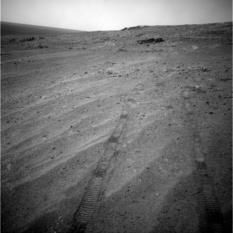
Ripple crossing
As January 2015 wound down, Opportunity was roving along en route to Spirit of St. Louis Crater when she encountered this small ripple field. Back in April 2005, Opportunity got stuck for 6 weeks in a ripple dubbed Purgatory Dune, and ever since ripples can strike fear into rover planners. But after they assessed this ripple field, the rover was given the green light to rove right on over it – and she did.NASA / JPL-Caltech
The really "exciting stuff" awaits just a few drives beyond Spirit of St. Louis Crater, in Marathon Valley. A strong signal from orbit of phyllosilicate signatures in the materials on the floor of the valley is what drew the team to this area of Endeavour's rim.
"It looks similar to the signature that drew us to Matijevic Hill, but it's larger and stronger," said Squyres. "That this signature is on the floor of a valley, a place that is topographically and presumably also stratigraphically low, provides a strong hint that this is going to be extremely interesting, because lower generally means older in a stratigraphic stack of rocks. We think Marathon Valley could be a window through these ejecta deposits into something older underneath and that's a hypothesis we can test when we get there."
The clays hidden along Endeavour's western rim were originally discovered with data from Compact Reconnaissance Imaging Spectrometer for Mars (CRISM) data in research by James Wray, (then of Cornell); Noe Dobrea, (then of JPL); Arvidson; S. M. Wiseman, WUSTL; Alfred McEwen, University of Arizona, Tucson; Squyres; Jack Mustard, Brown University; and Scott Murchie, Applied Physics Laboratory Johns Hopkins University. Their findings were published in Geophysical Research Letters on November 4, 2009.
"Now, we're within weeks of getting to the mother lode of clays," said Arvidson, who is also a co-investigator on CRISM and who has acquired additional orbital data to create mineralogical maps of Matijevic Hill and Marathon Valley to help the team zero in on the best of the best locations. "The view of Marathon Valley really is spectacular," Arvidson said. "It's not a deep valley, but it's definitely a major valley. And most of it is on the inboard side, that is tilted in toward the crater and we're just seeing the very western side of it. Once we get to Spirit of St. Louis Crater and Marathon Valley, it's a new mission. We're reinventing ourselves again."
As she's always been, Opportunity is ready to rove. As January gave way to February, the rover was producing 437 watt-hours of power, the Tau was hovering around 0.95, while and the dust factor was 0.59. "She's doing great. The rover is still performing really well," said Stroupe. "We continue to drive backwards and the right front wheel currents have been well-behaved," added Callas.
"Every day we are freshly amazed and rewarded that the mission is still going," Stroupe added. "Even in those days when we're exhausted, the vision behind this, why we're doing this and expending the energy, and that real feeling that it's always worth it, is always there. That carries us through. So the feeling is renewed every day and every one of us I think is grateful that we have this wonderful opportunity – pun not intended – that may never come again. Waking up every day and going to work on Mars," she said, "never gets old."
The Time is Now.
As a Planetary Defender, you’re part of our mission to decrease the risk of Earth being hit by an asteroid or comet.
Donate Today

 Explore Worlds
Explore Worlds Find Life
Find Life Defend Earth
Defend Earth


